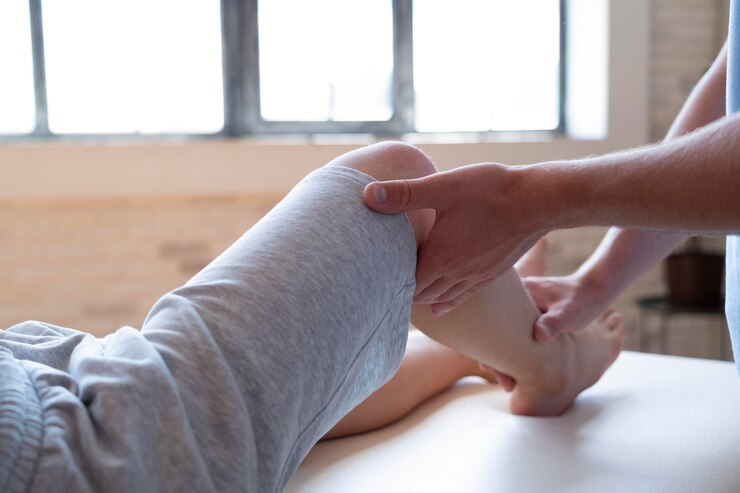Physiotherapy For Foot Fracture in Singapore
By Yuna ZhuangFoot fractures, including ankle fractures, are common injuries that can cause significant pain and swelling. This injury can limit basic functions like walking, running, or climbing stairs. If not treated, it can further hinder muscle strength and range of motion in the lower extremities.
Ankle fractures in particular account for 9% of all fractures in Singapore, with an annual incidence of more than 170 cases per 100,000 adults. A strong force impacting the foot can cause this fracture in several ways. To help recover from foot and ankle injuries, physical therapy is a crucial first step to holistic and conservative treatment.

Physiotherapists address such injuries using various techniques for fracture reduction and recovery. This article explores these methods and discusses the causes, symptoms, and diagnosis of foot fractures. We will also explore how physiotherapy treatment with proper exercise improves the healing process and helps prevent future injuries.
What is a Foot Fracture?
A foot fracture is a broad term encompassing one or more broken bones in the foot. This includes the toes (phalanges), the middle bones of the foot (metatarsals), the two small round bones at the base of the big toe (sesamoids), and the bones at the back of the foot, including the calcaneus or heel bone.
These breaks can range from minor stress fractures to complete breaks. Common types of foot fractures include the following:
- Metatarsal fractures
- Calcaneal fractures
- Jones fractures (in the fifth metatarsal)
A metatarsal fracture specifically refers to a break in the five long, thin bones on the bottom of the foot, connecting the toes to the ankle. These are some of the most common types of foot fractures among adults and children over five, especially the fifth metatarsal.
Causes of Foot Fractures
Several factors cause a fracture, especially following a traumatic event. If you have injured your foot, it's important to consult a medical professional to examine its severity.
Here are some common causes of a foot fracture:
- Direct impact: This could be from a fall, a sports injury, a vehicle accident, dropping a heavy object on your foot, landing from a jump, or hitting your foot on something hard or sturdy.
- Overuse: Stress fractures can develop from repetitive activities that put undue stress or fatigue on the bones in your foot.
- Medical conditions: Certain medical conditions, such as osteoporosis, can weaken bones and make them more susceptible to fractures.
- Sudden change of direction: This can occur when you roll your foot inward due to a sudden twist.
Symptoms of a Foot Fracture
The symptoms of a foot fracture can vary depending on the severity of the break and the location of the fracture. However, some common symptoms include:
- Sharp pain, especially when putting weight on the injured foot
- Swelling and inflammation
- Bruising and discolouration
- Reduced range of motion in the ankle or foot
- Difficulty walking and discomfort
- Tenderness in the affected area
- Noticeable difference in appearance
- Prolonged immobilisation
In other cases, foot and ankle fractures can damage nerve and connective tissues, causing loss of sensation in the injured foot or altered sensation such as coldness. This can impair your sense of navigating surfaces or perform complex movements.
Diagnosis of a Foot Fracture
If you suspect you have a foot fracture, see a doctor immediately for an initial consultation to discuss your symptoms. The doctor will examine your foot, checking for tenderness, swelling, and deformity. They might also assess your range of motion and ability to bear weight.
X-rays are the most common imaging test for foot fractures to identify severity. Foot or ankle fractures may be mistaken for severe joint sprains so it's important to rule this out.
In some cases, medical professionals may conduct additional tests like CT scans or MRIs for a more detailed view.
Physiotherapy Assessment for Foot Fractures
Once diagnosed with a foot fracture, your doctor may recommend physiotherapy as part of your treatment plan. Physical therapy helps regain mobility and strengthen your ankle and foot after its initial healing phase.
During the first assessment, your physiotherapist will:
- Assess the severity of your fracture
- Evaluate your pain level
- Measure the range of motion in your ankle and foot
- Check for muscle weakness or atrophy
- Discuss your goals for rehabilitation

In Singapore, experienced physical therapy providers for bone, muscle, joint, and tendon injuries like Phoenix Rehab create a personalised treatment plan tailored to your needs. After finding the exact diagnosis and cause of your pain, which is 33% of the problem, they solve this 33% using a "just-for-you" treatment and rehabilitation.
Physiotherapy Treatment for Foot Fractures
Physiotherapy treatment may vary depending on the extent of foot or ankle injuries and your current healing stage. Generally, treatment focuses on the following key areas.
Pain Reduction
Techniques such as ultrasound, electrical stimulation, and manual therapy can help reduce pain and inflammation after fractures.
Improving Range of Motion
Gentle stretching exercises are crucial for regaining full mobility in the ankle and foot. Physiotherapists will design a personalised programme to progressively improve your range of motion and prevent stiffness.
Manual Therapy
Massage and joint mobilisations can improve scar mobility and flexibility, especially after surgery. Scar tissue can restrict movement, and manual therapy techniques can help break down adhesions and restore normal tissue function.
Strengthening Muscles
As your fracture heals, physiotherapists may introduce exercises to strengthen the muscles around the ankle and foot. Stronger muscles improve stability and proprioception or body awareness, reducing the risk of future injuries.
Balance and Gait Training
Once weight-bearing is possible, balance and gait training exercises help regain confidence and improve walking patterns after a fracture.
Foot and Ankle Sensation Rehabilitation
Physiotherapists might use specific exercises or techniques like desensitisation or proprioceptive retraining to address potential nerve issues caused by the fracture. These techniques can help restore proper sensation in the foot.
Heat Treatments
In the later stages of rehabilitation, your physiotherapist may use heat therapy to improve blood circulation and promote healing.
Post Treatment Education
Finally, patient education on proper gait mechanics, activity modifications, and safe weight-bearing progression to optimise recovery and prevent re-injury should be part of your treatment plan.
Exercises
Reinstate a pain-free range of motion with recommended therapeutic exercises. Some common exercises used in physiotherapy for foot fractures include:
Calf Stretch
These stretches, performed with a straight back knee, help improve flexibility in the calf muscles, which can reduce pain and stiffness in the ankle. To perform a calf stretch:
- Stand straight facing a wall with your hands shoulder-width apart, placed at eye level on the wall for balance.
- Step one foot back approximately 3-4 feet from the wall.
- Keep your front heel flat on the floor and your back heel grounded as much as possible (depending on your flexibility).
- Lean forward from your hips, keeping your back straight and your core engaged. You should feel a stretch in the calf muscle of your back leg.
- Hold this position for 30 seconds. Breathe slowly and deeply throughout the stretch.
For those with limited balance or difficulty reaching a wall, this stretch can also be done using a sturdy piece of furniture like a chair or table.
Towel Scrunches
This exercise strengthens the intrinsic muscles of your foot, which are the small muscles located in the sole. These muscles maintain arch stability and proper foot function. To perform this exercise:
- Sit in a chair with your feet flat on the floor or stand with your feet shoulder-width apart.
- Spread the towel on the floor, with the long side facing you.
- Position your toes at the edge of the towel, keeping your heels on the floor if seated or flat on the ground if standing.
- Using only your toes, grip the towel and scrunch it towards you as if trying to pick it up with your toes.
- Hold the scrunched position for a few seconds, then slowly release your toes and allow the towel to flatten out.
Focus on using your toes to scrunch the towel, not your entire foot or leg muscles.
For added difficulty, try performing the towel scrunch exercise while standing on one leg at a time. Make sure you have good balance before attempting this variation.
Single-leg Stance
This exercise challenges your balance and strengthens the muscles in your ankle, foot, and leg, improving overall stability and your body's awareness of its position in space. To perform this stance:
- Stand with your feet hip-width apart and your arms down by your sides or outstretched for better balance.
- Slowly lift one leg off the ground, bending it slightly at the knee if needed. Keep your core engaged and your back straight.
- Hold this position for as long as you can comfortably balance on your single leg. Aim for at least 10-30 seconds.
Focus on keeping your standing leg straight, but avoid locking your knee. A slight bend should be fine.
If you feel any sharp pain or lose your balance, stop the exercise and consult your physiotherapist.
Conclusion
Physiotherapy helps people recover from foot fractures. A personalised physiotherapy treatment plan can reduce pain, improve mobility, strengthen the muscles around your foot and ankle, and help prevent future injuries. With dedication and consistent exercise, you can get back on your feet and walk pain-free.
Follow-up care is a vital part of your treatment, so keep tabs on your progress and any lingering symptoms.
Browse other articles by category
Physiotherapy for Knee Pain Physiotherapy For Slipped Disc Physiotherapy for Neck Pain PHYSIOTHERAPY
PHYSIOTHERAPY
 Hand Therapy
Hand Therapy
 Alternative
Alternative
 Massage
Massage
 Traditional Chinese Medicine Treatment
Traditional Chinese Medicine Treatment
 Rehab
Rehab
 Physiotherapy For Lower Back Pain
Physiotherapy For Shoulder Pain
Orthopedic Doctors, Insurance & Healthcare
Physiotherapy For Upper Back Pain
Frozen Shoulder
Physiotherapy for Back Pain
Physiotherapy For Lower Back Pain
Physiotherapy For Shoulder Pain
Orthopedic Doctors, Insurance & Healthcare
Physiotherapy For Upper Back Pain
Frozen Shoulder
Physiotherapy for Back Pain

 Whatsapp us now
Whatsapp us now